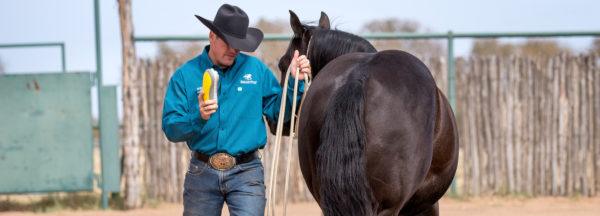Safe Horse Grooming


May NWC Video Preview: Grooming
Clinton Anderson from Downunder Horsemanship has developed a way to train horses, regardless of their past problems or traumas. It all begins with training the owners so they can gain their horses’ respect and understand how to properly control them. Join Clinton on his weekly endeavors of tackling some of the most challenging situations with problem horses, and problem owners. This week, we watch as Clinton gives us some vital information on grooming your horse.
Clinton begins by introducing us to his horse, Zorro. He’s a new horse that doesn’t know any of the Downunder Method, so he’s a great horse to use for this demonstration. Clinton’s listeners usually ask a lot of questions, especially about horses standing still in the cross tie during grooming. Clinton starts off by saying that he actually hates cross ties and that they’re unsafe. He also explains that they encourage your horse to use the reactive side of their brain. So, naturally, your horse is going to start fussing.
Instead, whenever Clinton has a grooming problem, saddling problem, bathing problem, or any situation where you want to want to get your horse to relax and stand still, he lets the horses move. Bring your horse to the roundpen or a similar area where the horse has room to move his feet and start training. You can’t fix your horse’s behavioral problems in a tightly confined area like a saddling bay, wash rack, or alleyway of a barn. If you attempt to work in a small area and something bad happens, it’s going to be dangerous for both of you.
To fix a horse’s grooming issues, take him to the roundpen and then start brushing him. When he starts getting reactive and fussing, take his negative energy and do something constructive with it. The roundpen provides a good safety net for this. When you go to brush your horse, start with his back—the least sensitive part of the horse’s body. If your horse starts acting up, the first thing you need to do is drop the brush and start working his feet. A great exercise to practice is to disengage the rear end through the practice of Yielding the Hindquarters Stage One. After moving the horse’s feet and when he’s tuned in to you, let him come to a stop and immediately pick up the brush and go back to grooming. The second he starts fidgeting and not standing still, immediately drop your brush and move his feet around again.
The goal is to get the horse to realize that standing still and relaxing is a much better deal than having to move his feet. You can use the groundwork exercises from the Downunder Horsemanship Method to take your horse’s negative energy and create a positive, especially with a 14-foot lead rope and the right halter.
As the horse’s training progresses and he gains confidence, you can eventually groom him in a saddling bay or a more confined area. Just remember that the smaller the area, the less room you have to work with and the higher the risk if the horse reacts.
To learn more about the Clinton Anderson training method, become a member of the No Worries Club, or to get information on any of the products seen on our show, head over to our homepage and download the Downunder Horsemanship app today! If you’re interested in getting accelerated results, let a Clinton Anderson Professional Clinician or Ambassador bring the Method to you!

